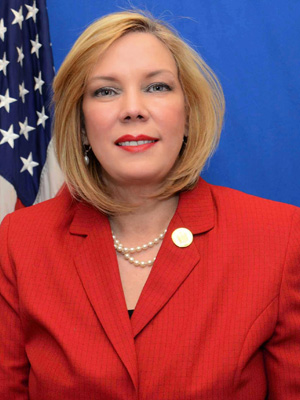2023-04
Support and Improve Required Transition Counseling for Service Members of Color
Sponsored by Sen. Nilsa Cruz Pérez (NJ)
Reported to the Caucus by the NHCSL Veterans and Military Affairs Task Force
Sen. Nilsa Cruz Pérez (NJ), Chair
Unanimously ratified by the Caucus on December 2, 2023.
WHEREAS, in Resolution 2017-10, Ending Veteran Homelessness, this Caucus identified increasing connections to employment as one of the strategies to end veteran homelessness[1] because unemployment is one of its main causes; and,
WHEREAS, at the time, research showed that “more than two-thirds of veterans consider ‘finding a job’ as the greatest challenge in transitioning to civilian life (69%);”[2] and,
WHEREAS, in other to help tackle this issue, the John S. McCain National Defense Authorization Act for Fiscal Year 2019[3] revamped and expanded the service member transition assistance program (TAP) that had been mandated under the Veterans Opportunity to Work (VOW) to Hire Heroes Act of 2011,[4] by codifying a curriculum; and,
WHEREAS, regarding the transition to civilian employment, the law requires TAP to include, “one day of instruction regarding preparation for employment [and] two days of instruction regarding a topic selected by the member from the following subjects:
(i) Preparation for employment.
(ii) Preparation for education.
(iii) Preparation for vocational training.
(iv) Preparation for entrepreneurship.
(v) Other options determined by the Secretary concerned;”[5] and,
WHEREAS, this new curriculum came into effect on October 2019 and also includes “one day of pre-separation training specific to the armed force concerned [and] one day of instruction regarding benefits under laws administered by the Secretary of Veterans Affairs and other subjects;”[6] and,
WHEREAS, federal law also requires that the Departments of Defense and Homeland Security, respectively, “establish permanent employment assistance centers at appropriate military installations,”[7] but does not define what an “appropriate” installation is, leaving it up to the discretion of the departments, and thus about 300 have been established worldwide;[8] and,
WHEREAS, according to the Government Accountability Office (GAO), as of fiscal year 2018, and prior to the revamped curriculum, “138,256 (90 percent) of eligible separating active duty servicemembers; 12,069 (57 percent) of National Guard members; and 13,630 (64 percent) of eligible reserve servicemembers participated in TAP;”[9] and,
WHEREAS, despite this high participation, Gulf War-era II veterans[10] have shown a consistently higher rate of unemployment (3.0% in March 2022, 2.8% in March 2023) when compared to Gulf War-era I veterans[11] (1.4% in March 2022, 2.2% in March 2023); [12] and,
WHEREAS, one reason for this disparity may be that Hispanics are a much higher proportion[13] of among Gulf War-era II veterans than Gulf War-era I veterans and Hispanics in general have the highest or second highest[14] unemployment rate in the civilian workforce,[15] with research showing that “minority veterans have a 44% higher risk of unemployment than non-minority veterans.”[16]
THEREFORE, BE IT RESOLVED, that the National Hispanic Caucus of State Legislators applauds the improvements in the Transition Assistance Program and calls on the Departments of Defense, Homeland Security, Labor and Veterans Affairs, as applicable, to enhance the curriculum’s topical content, within the guidelines mandated by Congress, to include strategies to confront and overcome racial and ethnic discrimination in civilian life.
THE MILITARY AND VETERANS AFFAIRS TASK FORCE UNANIMOUSLY RECOMMENDED THIS RESOLUTION TO THE EXECUTIVE COMMITTEE FOR APPROVAL. THE EXECUTIVE COMMITTEE UNANIMOUSLY APPROVED THIS RESOLUTION AT ITS MEETING OF APRIL 23, 2023, IN SAN JUAN, PUERTO RICO.
THE NATIONAL HISPANIC CAUCUS OF STATE LEGISLATORS UNANIMOUSLY RATIFIED THIS RESOLUTION ON DECEMBER 2, 2023 AT ITS ANNUAL MEETING IN PHILADELPHIA, PENNSYLVANIA.
[1] Resolution 2017-10 (citing 10 Strategies to End Veteran Homelessness. (2016). United States Interagency Council on Homelessness. https://www.usich.gov/resources/uploads/asset_library/Ten_Strategies_to_End_Veteran_Homelessness.pdf)
[2] The Iraq and Afghanistan Veterans of America and Prudential. Veterans’ Employment Challenges: Perceptions and experiences of transitioning from military to civilian life. (2012). https://eoa.oregonstate.edu/sites/eoa.oregonstate.edu/files/veterans_employment_challenges.pdf
[5] 10 U.S. Code § 1144(f)
[6]10 U.S. Code § 1144(f)
[7] 10 U.S. Code § 1143(b)
[8] Government Accountability Office (GAO). GAO-19-438R Transitioning Servicemembers. (June 17, 2019). Available at https://www.gao.gov/assets/gao-19-438r.pdf
[9] Government Accountability Office (GAO). GAO-19-438R Transitioning Servicemembers. (June 17, 2019). Available at https://www.gao.gov/assets/gao-19-438r.pdf
[10] The Bureau of Labor Statistics (BLS) defines Gulf War era II veterans as those who served September 2001-present.
[11] The BLS defines Gulf War era II veterans as those who served August 1990-August 2001.
[12] BLS. Current Population Survey, Table A-5. Employment status of the civilian population 18 years and over by veteran status, period of service, and sex, not seasonally adjusted. Available at https://www.bls.gov/news.release/empsit.t05.htm
[13] Adrianna Rodriguez, Latinos are fastest growing population in US military, but higher ranks remain out of reach (USA Today, Jun. 11, 2020).
[14] Depending on the month, Hispanics switch ranks with Blacks.
[15] BLS. Current Population Survey, Table A-3. Employment status of the Hispanic or Latino population by sex and age https://www.bls.gov/news.release/empsit.t03.htm and Table A-2. Employment status of the civilian population by race, sex, and age https://www.bls.gov/news.release/empsit.t02.htm
[16] DIVERSITY, EQUITY, AND INCLUSION. U.S.VETS. https://usvets.org/dei/


